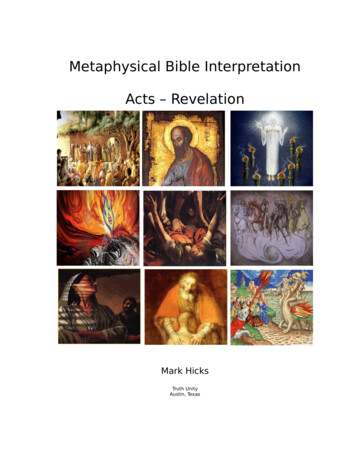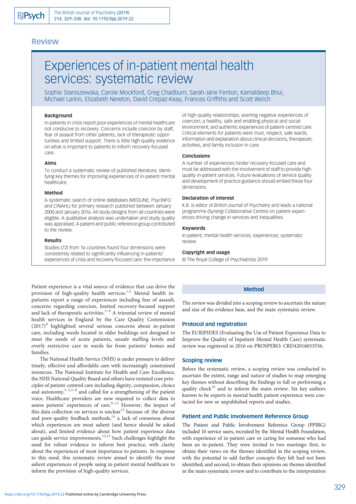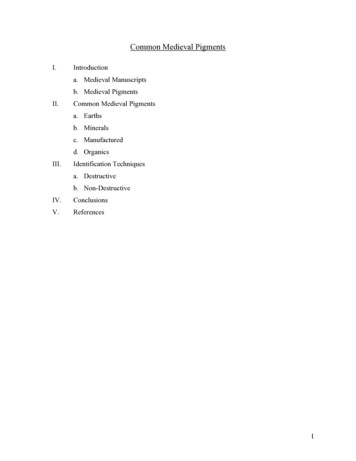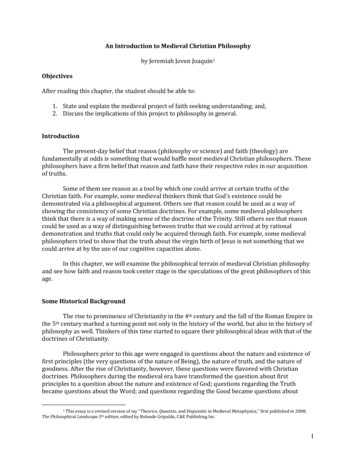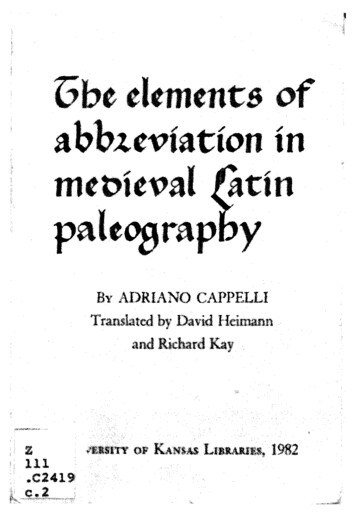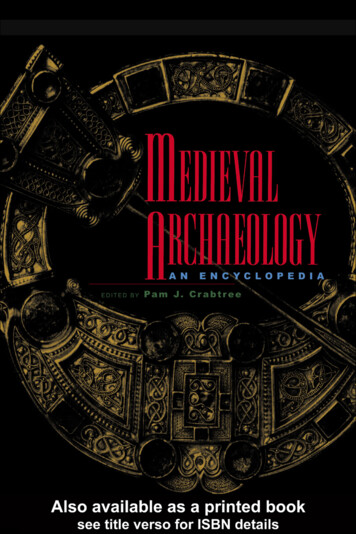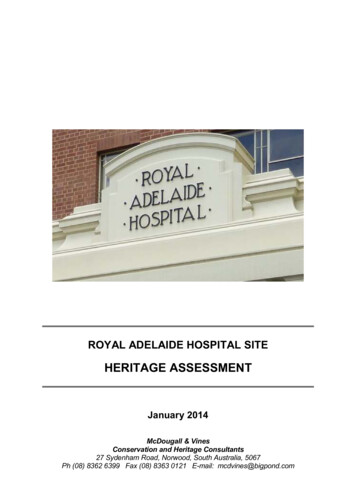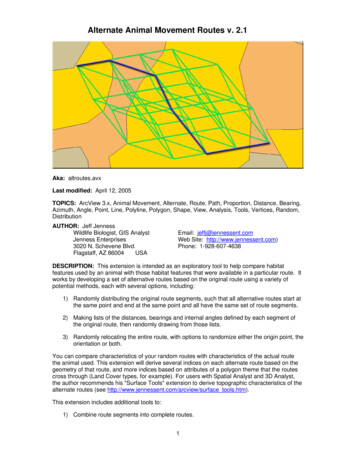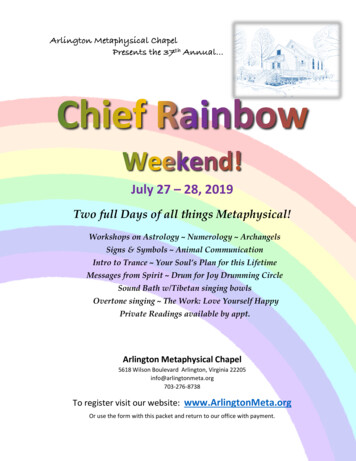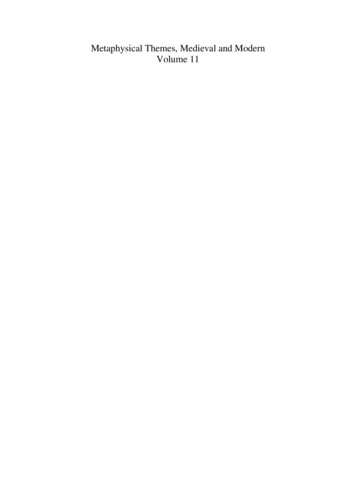
Transcription
Metaphysical Themes, Medieval and ModernVolume 11
Also available in the series:The Immateriality of the Human Mind, the Semantics of Analogy,and the Conceivability of GodVolume 1: Proceedings of the Society for Medieval Logic and MetaphysicsCategories, and What Is BeyondVolume 2: Proceedings of the Society for Medieval Logic and MetaphysicsKnowledge, Mental Language, and Free WillVolume 3: Proceedings of the Society for Medieval Logic and MetaphysicsMental RepresentationVolume 4: Proceedings of the Society for Medieval Logic and MetaphysicsUniversal Representation, and the Ontology of IndividuationVolume 5: Proceedings of the Society for Medieval Logic and MetaphysicsMedieval Skepticism, and the Claim to Metaphysical KnowledgeVolume 6: Proceedings of the Society for Medieval Logic and MetaphysicsMedieval Metaphysics; or Is It "Just Semantics"?Volume 7: Proceedings of the Society for Medieval Logic and MetaphysicsAfter God, with Reason Alone—Saikat Guha Commemorative VolumeVolume 8: Proceedings of the Society for Medieval Logic and MetaphysicsThe Demonic Temptations of Medieval NominalismVolume 9: Proceedings of the Society for Medieval Logic and MetaphysicsSkepticism, Causality and Skepticism about CausalityVolume 10: Proceedings of the Society for Medieval Logic and MetaphysicsMetaphysical Themes, Medieval and ModernVolume 11: Proceedings of the Society for Medieval Logic and Metaphysics
Metaphysical Themes, Medieval and ModernVolume 11:Proceedings of the Societyfor Medieval Logic and MetaphysicsEdited byGyula Klima and Alexander W. Hall
Metaphysical Themes, Medieval and ModernVolume 11: Proceedings of the Society for Medieval Logic and Metaphysics,Edited by Gyula Klima and Alexander W. HallThis book first published 2014Cambridge Scholars Publishing12 Back Chapman Street, Newcastle upon Tyne, NE6 2XX, UKBritish Library Cataloguing in Publication DataA catalogue record for this book is available from the British LibraryCopyright 2014 by Gyula Klima, Alexander W. Hall and contributorsAll rights for this book reserved. No part of this book may be reproduced, stored in a retrieval system,or transmitted, in any form or by any means, electronic, mechanical, photocopying, recording orotherwise, without the prior permission of the copyright owner.ISBN (10): 1-4438-5386-0, ISBN (13): 978-1-4438-5386-6
TABLE OF CONTENTSIntroduction . 1Alexander W. HallPart One: Metaphysical Themes: 1274-1671Remarks on Pasnau’s Metaphysical Themes: 1274-1671 . 9Andrew W. ArligCategories and Modes of Being: A Discussion of Robert Pasnau’sMetaphysical Themes . 27Paul SymingtonResponse to Arlig and Symington . 57Robert PasnauPart Two: Substance Ontology, Medieval and ModernAn Argument for Hylomorphism or Theism (But Not Both) . 75Travis DumsdayThe Rises and Falls of Analysis and Metaphysics: Commentson “An Argument for Hylomorphism or Theism (But Not Both)”by Travis Dumsday. 85Gyula KlimaResponse to Gyula Klima’s “The Rises and Falls of Analysisand Metaphysics” . 89Travis DumsdayRejoinder to Travis Dumsday’s Response . 93Gyula Klima
viTable of ContentsPart Three: The Natural Theology of Thomas AquinasThe Burden of Proof: Aquinas and God Science . 97Alexander W. HallComments on Alexander W. Hall’s “The Burden of Proof: Aquinasand God Science” . 117Michael SirillaResponse to Michael Sirilla’s Comments . 123Alexander W. HallAppendix . 129Contributors . 131
INTRODUCTIONALEXANDER W. HALLThe Proceedings of the Society for Medieval Logic and Metaphysics(PSMLM) collects original materials presented at sessions sponsored bythe Society for Medieval Logic and Metaphysics (SMLM). Founded byGyula Klima (Director), Joshua Hochschild, Jack Zupko and JeffreyBrower in 2000 (joined in 2011 by Assistant Director and Secretary,Alexander Hall) to recover the profound metaphysical insights of medievalthinkers for our own philosophical thought, the Society currently has overa hundred members on five continents. The Society’s maiden publicationappeared online in 2001 and the decade that followed saw the release ofeight more volumes. In 2011, PSMLM transitioned to print. Sharp-eyedreaders of these volumes will note the replacement of our (lamentablycopyrighted for commercial use) lions, who guarded the integrity of thebody of an intellectual tradition thought to be dead, with the phoenixesthat mark our rebirth. Friends of the lions will be happy to note that theyremain at their post, protecting SMLM’s online proceedings andannouncements at http://faculty.fordham.edu/klima/SMLM/.This volume gathers papers read by SMLM members at the 2012 meetingsof The International Congress on Medieval Studies (ICMS) and TheAmerican Catholic Philosophical Association (ACPA). Parts I and II(taken from the ICMS and ACPA sessions, respectively) look at importantfigures in the history of the study of the metaphysics of substance over thelast eight centuries. Attention to this period sheds light on contemporarydisputes as well as the history of thought that leads into the modern period.The essays in Part III, read at the ACPA’s SMLM satellite session, presentvying, contemporary interpretations of what metaphysical and logicalpresuppositions underlie the natural theology of Thomas Aquinas.
2IntroductionPart I: Metaphysical Themes: 1274-1671The ICMS session papers that make up Part I discuss Robert Pasnau’sMetaphysical Themes: 1274-1671 (Oxford University Press, 2011), whichtreats the metaphysics of substance over the four centuries that separatethe deaths in 1274 of Aquinas and Bonaventure from the completion of thefirst drafts of Locke’s Essay Concerning Human Understanding in 1671,thereby picking up with early critics of classical scholasticism anddrawing to a close in the birth of the modern period. The narrative in sixparts concerns the material substratum of change, material substances andtheir properties, modes or accidents, and the persistence of substances overtime. Though a single session of papers cannot do justice to Pasnau’s richstudy, the essays in this volume speak to central concerns of the work,namely, category theory and medieval mereology.Medieval mereology is the study of parts, wholes and the relationsbetween them that develops out of Plato’s use of the method of collectionand division to demarcate natural kinds and Aristotle’s discussions of partsand wholes in Metaphysics and Topics.1 In his “Remarks on Pasnau’sMetaphysical Themes,” Andrew Arlig reflects on Pasnau’s discussions ofholenmerism and nominalist approaches to identity over time.Holenmerism is the thesis that one thing can be present as a whole in amultiplicity of discrete things, as most scholastic thinkers2 believe therational human soul to be present in the body’s integral parts and God ineverything. In response to Pasnau’s suggestion that, were it the case thatimmaterial things exist, holenmerism would be a plausible candidate todistinguish them from material things, Arlig expands upon arguments byHenry More that call into question the possible unity of holenmers (which,like universals, must exist wholly in discrete things) to argue thatholenmerism is incoherent. Arlig then turns to Pasnau’s discussion of JohnBuridan on identity over time, taking issue with Pasnau’s statement thatBuridan denies persistence across time for humans and other animals.1See Andrew Arlig, “Medieval Mereology”, The Stanford Encyclopedia ofPhilosophy, first published 2006, revised 2011 (latest version on-line: al/); and “Mereology”, Encyclopedia ofMedieval Philosophy, edited by Henrik Lagerlund (Springer, 2011).2And not just scholastics. The list of figures who subscribe to the existence ofholenmers would include Plotinus, Augustine and Descartes, to name but a few.For references, see Metaphysical Themes p. 337 n. 18.
Alexander W. Hall3Agreeing that some arguments against universals will probably workequally well against holenmers, Pasnau notes that by limiting the existenceof holenmers to God and the rational soul, one may preserve the unity ofholenmers by pointing to the fact that, unlike universals, holenmers haveoperations beyond those they perform in discrete parts of things. Pasnauthen contends that Buridan’s nominalism prohibits him from acceptingthat two things similar and yet somehow distinct can ever literally bedescribed as identical (as one and the same universal cannot subsist indisparate individuals), and hence, whatever commonsense ontology maysuggest, persons (for instance) cannot persist across time in the literalsense that would require that their parts remain the same.As regards the categories, Aristotle describes them as a division of “thingsthat are” (Categories (Cat.) 1a20);3 but whether the things in question areextramental, linguistic or mental entities (or some combination thereof) isunclear.4 On the one hand, Aristotle states that accidental and universalfeatures cannot exist apart from the individual substances whom theycharacterize (Cat. 2b4-6), thereby inverting a Platonic realism thathypostasizes universal features into unique, immaterial, paradigmaticforms, participation in which renders individuals the types of things thatthey are (hence many beautiful things would be more or less beautiful tothe extent they participate in the form of beauty).5 On the other hand,Aristotle presents the ten categories themselves as a list of “things saidwithout any combination” (Cat. 1b25), thereby giving rise to theimpression that the work is about terms or what they call to mind.Mid-thirteenth-century interpretations of the Categories are shaped by thereception in the Latin West of the complete writings of Aristotle, viewedin part through the lens of his Islamic commentators. Responding to (1)the distinction between concepts of first and second intention (i.e.,concepts of things in the world, e.g., cats, and concepts about theseconcepts, e.g., the species cat, respectively); (2) attention to the boundaries3All translations from Categories are from Aristotle’s “Categories” and “Deinterpretatione,” trans. and ed. J. L. Ackrill, Clarendon Aristotle Series (Oxford,1963).4See Jorge J. E. Gracia, “Categories Vs. Genera: Suárez’s Difficult BalancingAct,” in Categories and What Is Beyond, Gyula Klima and Alexander Hall eds.,Proceedings of the Society for Medieval Logic and Metaphysics vol. 2 (CambridgeScholars Publishing, 2011), 7-18.5See, e.g., Republic 504e–518c; 596e–597a, Phaedo 100b–102a3, and Phaedrus247c3–247e6.
4Introductionof various Aristotelian sciences (such as metaphysics, physics and logic);and (3) Aristotle’s notion of an isomorphism between things, concepts andwords, medieval thinkers enter into a sustained dialog regarding theontological status of substances and the accidents (making up the othernine categories) that depend on these substances for their existence (as aquality, for instance, cannot exist apart from its subject)6 and wonderwhether there exists a method (a sufficientia praedicamentorum) to fix thenumber of categories, either through attention to predication, with thebelief that such corresponds to some extent to ways in which things are (aswe see in Albertus Magnus and Thomas Aquinas) or by attention tovarious modes of being (as with Simon Faversham and Radulphus Brito).These different medieval accounts of what the categories categorize andhow to fix the number of categories have led contemporary scholars toclass medieval accounts with reference to whether or not they arereductionist or deflationary, with reductionist accounts seeking to reducethe number of irreducibly different types of beings picked out by theaccidental categories (as we see in fourteenth-century authors such asOckham and Buridan) and deflationary accounts interpreting talk ofaccidents as of ways in which substances exist, with these accountsranging from a realism that views accidents as beings (though less realthan the substances in which they inhere) to eliminitivism.7Robert Pasnau and Paul Symington are in broad agreement that Aquinas’saccount of the accidental categories is deflationary, whereas the two differover whether it is reductionist, with Symington contending in his“Categories and Modes of Being” that this is the case and that Aquinasdevelops his account via an approach (idiosyncratic relative to laterscholastics) to metaphysics involving the real distinction between essenceand existence, the analogy of being and an isomorphism between thoughtand reality, concluding with remarks on the limitations of Pasnau’sapproach to metaphysics in general given what Symington describes asPasnau’s resistance to viewing conceptual or linguistic structures as usefulguides to the practice.6Though medievals allow that such is possible through divine agency, as intransubstantiation, wherein the accidents (appearance, smell, etc.) of bread andwine persist absent the substance of the host.7Good places to begin sorting out these various issues regarding medievalinterpretations of Aristotle’s Categories are the article on this topic by Jorge J. E.Gracia and Lloyd Newton in the Stanford Encyclopedia of Philosophyhttp://plato.stanford.edu/entries/ medieval-categories/#ThiCen and Newton ed.,Medieval Commentaries on Aristotle’s Categories, (Brill, 2008).
Alexander W. Hall5In response to Symington, Pasnau speaks to the value of what ordinarytalk can tell us of the world, reckoning attention to such one of thevaluable features of scholastic metaphysics, while cautioning that it isunlikely language serves as a guide to what fundamentally exists. Asregards the claim that Aquinas looks on the accidental categories as eachcorresponding to an irreducible kind of being, Pasnau contends that forAquinas this likely holds only for the categories of quantity and quality,marking the lesser accidental categories as mere structures or features ofreality, not themselves items over and above the items in the othercategories, illustrating this with reference to Aquinas’s treatment of thecategories of action and passion.Part II: Substance ontology, medieval and modernPart II concerns the development of analytic metaphysics and principal,competing theories in contemporary substance ontology literature: (1)substratum theory (2) bundle theory (3) primitive substance theory and (4)hylomorphism. The respective theories construe material objects as (1)bare substratum-attribute compounds (2) aggregates of properties (3)primitively unified and individuated or (4) prime matter-substantial formcompounds. Travis Dumsday’s “An Argument for Hylomorphism orTheism (But Not Both)” contends that concerns bound up with (1) forcethe substratum theorist either to abandon (1) for (4) or to recognize theexistence of a causal agent or agents operating outside the laws of nature,and thereby move in the direction of some form of theism or, at the least, adenial of metaphysical naturalism, closing with some reflection on therelevance of substance ontology to natural theology.Gyula Klima’s “The Rises and Falls of Analysis and Metaphysics” seesthe substratum theorist’s dilemma as a result in part of a desire formetaphysical novelties that grew out of the logical positivists’ convictionthat the study of the history of philosophy offers little of value. Klimajudges Dumsday’s attempt to saddle the substratum theorist with adilemma a success, adding that analysis likewise reveals that thesubstratum theorist’s notion of bare-particularity is self-contradictory, asthe truth of the statement ‘x is a bare particular’ assigns the bare particulara property, viz., bare-particularity, given that, as Klima contends in hisrejoinder to Dumsday’s reply (which works on multiple fronts to save thesubstratum theorist from advancing an open contradiction), ‘bareparticular’ must here indicate a common predicable rather than a directlyreferring term, like a singular term.
6IntroductionPart III: The natural theology of Thomas AquinasIn Part III the discussion turns from analysis, metaphysics, substanceontology and the importance of the latter to natural theology to the naturaltheology of Thomas Aquinas in particular, whose Five Ways are generallytaken to be demonstrative proofs of the type Aristotle terms ‘that’ or ‘hoti’(rendered ‘quia’ in Latin) in Posterior Analytics (An.Post). Such proofsare thought to be able to reason from phenomena to the existence of whatis their cause. Recent scholarship issuing from Radical Orthodoxy thinkersCatherine Pickstock and John Milbank, however, contends that the proofsare merely probabilistic. Again, Aquinas’s own Commentary onAristotle’s “Posterior Analytics” rules out quia proof in the ordinary senseas regards God. Alexander Hall’s “God Science” disputes Pickstock andMilbank on the status of the Five Ways as demonstrative and identifies thetype of quia proof at work in the arguments as the ‘through the accidents(per accidens)’ variety discussed at An.Post. 2, 8-10, illustrating this thesiswith reference to the First Way.Michael Sirilla’s comments on Hall’s paper accept Hall’s criticism ofPickstock and Milbank as well-founded, while noting that if per accidensquia proof of the type Hall describes really is at work in the First Way, itwould render the proof invalid as (what Sirilla takes it to be) ademonstration of God’s existence, as the First Way would then showrather only that some first mover exists. Hall’s response acknowledges thisdifficulty in his account of Aquinas and notes that it arose from his havingsupposed that the First Way would use the same form as the syllogism thatAquinas uses to illustrate per accidens quia proof. Unfortunately, theproof that Aquinas uses to illustrate per accidens quia proof falls prey to aformal fallacy. Nevertheless, this difficulty is not endemic to per accidensquia proof as such and therefore does not vitiate the First Way, which Hallreconstructs as a valid per accidens quia proof intended by Aquinas todemonstrate the existence of God and not merely some first mover.
PART ONE:METAPHYSICAL THEMES:1274-1671
REMARKS ON PASNAU’SMETAPHYSICAL THEMES: 1274-1671ANDREW W. ARLIGRobert Pasnau’s Metaphysical Themes is a bold work, covering a largeswath of relatively unknown and sometimes underappreciated material. Itis a tremendous contribution to the study of both medieval and earlymodern philosophy. Pasnau’s subject is material substance as it wasunderstood by thinkers living and working in the period between thefourteenth century and the seventeenth. He surveys the views of both wellknown philosophers (including Ockham, Buridan, Suarez, as well asHenry More, Pierre Gassendi, and René Descartes) and many lesserknown figures, some of whom deserve more attention (my votes go toJohn Wyclif and Anne Conway). By bringing this body of work into view,Pasnau reveals a number of interesting avenues for future research, both inmedieval philosophy and in early modern philosophy.When I say that Pasnau’s focus is material substance, I mean that heconsiders almost every conceivable way of analyzing material substances:their essences, their parts, their properties and modes, their identity andpersistence conditions, and so forth. Given the ambitious sweep of thisstudy and the amount of space at my disposal, clearly I can cover only asmall part of Pasnau’s book. In the following remarks, I will focus on twoissues that arise in the book. I hope that by detaching these topics from thecomplex whole of which they are parts, I have not distorted Pasnau’sviews inappropriately.1. Holenmerism (chapter 16)1As Pasnau notes, the standard Scholastic line on immaterial things—including, in particular, the intellective soul of a human being—is that1Unless otherwise specified, all page references are to Robert Pasnau,Metaphysical Themes 1274-1671. Oxford: Clarendon Press, 2011. And unlessotherwise noted, translations are mine.
10Remarks on Pasnau’s Metaphysical Themes: 1274-1671they are present in every region or part of a body as a whole (p. 337). Thiscommitment comes in degrees. Aquinas, for example, holds that everysubstantial form exists as a whole in each part of the composite substance.2Many later thinkers, including those in the so called “nominalist” camp(such as Ockham, Buridan, and Nicole Oresme) assert that it is only theintellective, or rational, soul that exists as a whole in the whole body andas a whole in each part of the body (tota in toto et tota in qualibet partecorporis). So, for example, in what is thought to be his first series oflectures on Aristotle’s On the Soul, Buridan clarifies the ways in which ananimal or plant soul is wholly in its body:Here then is the first conclusion: If we interpret “whole” categorematically,the whole soul of a horse is in the whole body. This is clear because [thesoul] is extended through the whole body. The second conclusion: If weinterpret “whole” syncategorematically, it should be accepted that thewhole soul of a horse is in the body. This is clear because each part of thesoul of the horse is in the body. But if we interpret “whole”syncategorematically, it is false that the whole soul of a horse is in thewhole body and in each part of [the horse]. This is clear since it is falsethat each part of the soul of a horse is in each part of the body. The part ofthe horse’s soul which is the part in the eye is not in the foot.3Or, consider this assertion in a question on Aristotle’s On the Soulattributed to Nicole Oresme:This kind of soul is not in every part as a whole, not integrally, notpotentially, and not essentially. That it is not integrally is obvious, sincethe part that is in the foot is not in the hand. Nor is it potentially, since it isnot the case that all the powers are in every part. Nor is it essentially, as Iexplained previously, since the part that is in the hand is not soul, butsomething belonging to soul. For this reason, Aristotle compares asensitive soul to a figure. For example, the figure of a quadrangle is not ineach part of a quadrangle.42See for example, Summa Theologiae 1a 76.8c.Buridan Quaestiones in Aristotelis De anima (prima lectura) 2.6 (Patar ed., pp.284-5, lines 122-32). (Text: Benoît Patar (ed.) Le Traité de l’Âme de Jean Buridan[de prima lectura]. Philosophes Médiévaux 29. Louvain-la-Neuve / Longueuil(Quebec): Éditions de l’Institut Supérieur de Philosophie / Éditions du Préambule,1991.)4Oresme Quaestiones in Aristotelis De anima 2.4 (Patar ed., p. 144, lines 108-15).(Text: Benoît Patar (ed.) Nicolai Oresme Expositio et Quaestiones in Aristotelis‘De Anima’. Philosophes Médiévaux 32. Louvain-la-Neuve / Louvain-Paris:Éditions de l’Institut Supérieur de Philosophie / Éditions Peeters, 1995.)3
Andrew W. Arlig11In short, the soul of a non-human animal or a plant is “extended as itsbody is extended” (extensa extensione sui corporis), and hence the wholesoul is in the whole body only because one part of the soul imbues onepart of the body and no part of the soul is not imbuing some part of thebody.5 The rational soul of a human, however, “is not extended in themanner that its body is extended”,6 and thus it can be wholly in each part:Again, if in a human there is not some other soul, then it ought to be saidwithout qualification (absolute) that the whole soul of a human and everypower is in every part of a human, and hence that the intellective [power],the visual [power], and so on, are in the foot. But if in a human there isanother soul and form—such as a sensitive [soul]—then one should say thesame thing about those [lower souls] as [it will be said] about the souls ofbrutes.7Indeed, if the rational soul is mereologically simple, then there is no otherway in which it could animate the whole body:Now we should briefly elaborate upon the intellective [soul] (about whichmore is to be made apparent in Book 3). I say that [the intellective soul] isnot whole properly speaking, because “whole” is not said of anythingexcept a divisible thing having parts (although sometimes it is improperlysaid of an indivisible thing). And, thus, it should be said that an intellectivesoul is in each part as a whole in this manner [i.e. improperly] because itinforms a body and is not extended as a body is extended (extensa adextensionem corporis). Thus, it follows that in every part either it or part ofit is, and given it does not have a part, it follows that in every part it existsas a whole.8Later on in the same question, we are given an explanation fordifference. The human intellective soul is a form that is not drawnfrom the potentiality of the matter.9 And it is for this reason thatintellective soul is not extended throughout the body in the way thatbody itself is extended. That is, unlike a body or non-human soul,5theoutthethetheBuridan Quaestiones in De anima (prima lectura) 2.6 (Patar ed., p. 281, line 68).Ibid., lines 66-67.7Oresme Quaestiones in De anima 2.4 (Patar ed., p. 142, lines 50-5).8Oresme Quaestiones in De anima 2.4 (Patar ed., p. 142, lines 39-47). See alsoBuridan Quaestiones in De anima (prima lectura) 2.6 (Patar ed., p. 283, lines 1059).9Oresme Quaestiones in De anima 2.4 (Patar ed., p. 145, lines 133-39 and 14347).6
12Remarks on Pasnau’s Metaphysical Themes: 1274-1671intellective soul is not extended by having one part here and another partthere.Pasnau sees in the doctrine of holenmerism a “promising” way todemarcate the immaterial from the material: “All and only material thingshave corpuscular, non-holenmeric structure” (p. 342). Of course, thismethod for marking the material off from the immaterial can only succeedif holenmerism is intelligible and ontologically principled. In this section,I will try to raise some concerns about holenmerism.Let me restate the doctrine of holenmerism with a little more precision. Anentity X is holenmerically present in something else, Y, if and only if, Yhas integral parts and for each integral part of Y, the whole of X exists inthat part.10 Specifically for my purposes, this fact about a holenmeric soulis important:If a soul is holenmerically present in a body, the soul will be present in atleast two parts of the body, P1 and P2, in such a way that the soul is whollypresent in P1 and it is wholly present in P2, and P1 is mereologicallydiscrete from P2.11To say that “the soul is wholly present in some part Pn” is to say thatIf S1 Sn are the parts of the soul, then the soul is present in a part Pn onlyif S1 is present in Pn and S2 is present in Pn and Sn is present in Pn.1210The restriction to “integral” parts is here because medieval authors tend torecognize a host of different kinds of parts, some of which probably cannot behosts for holenmers. There is no common definition of integral parts, but manymedieval philosophers characterize integral parts as proper parts (in contrast to thecontemporary mereological notion of an improper part), which comprise some sortof quantity. For more on the types of parts in medieval mereologies, consultAndrew Arlig “Medieval Mereology”, The Stanford Encyclopedia of Philosophy,first published 2006, revised 2011 (latest version y-medieval/).11X is mereologically discrete from Y if and only if no part of X is a part of Y andno part of Y is a part of X. Of course, it is not true that every pair of parts of thebody that one could pick out are discrete from one another. Some pairs will beoverlapping parts. But in the cases we are interested in, there will be noncoincident overlapping parts (say, my forearm and my hand), which entails thatthere will be at least two parts of the body that do not overlap at all (e.g., the oneinch long part near my elbow and the index finger).12If the soul is simple, then the only part of the soul is the soul itself, and then itwould follow as Oresme notes that the soul is present in Pn only if the soul’s
Andrew W. Arlig13Now let us consider a criticism of holenmerism by Henry More:[I]t is the same as if someone were to say that there is nothing of the soulthat is not included within [bodily part] A, and yet that, at the samemoment of time, [ ] the whole soul is in [some distinct bodily part] B, asif the whole soul were outside its whole self. This is clearly impossible inany singular and individual thing. As for universals, they are not things,but rather notions we apply in contemplating things.13More observes that if a soul were present holenmerically in a body, then itwould behave as a universal is often said to behave. But More thinks thatthere is something metaphysically unprincipled about this. No concretething can behave in the manner that a universal behaves.To see the parallel, consider the classical understanding of a universal as athing that can be wholly present in many discrete particulars at the sametime.U is a universal if and only if it can be wholly present in an individual I1and wholly present in another individual I2 at the same time, where I1 ismereologically discrete from I2.This notion of a universal was famously problematized by Boethius in hissecond commentary on Porphyry’s Isagoge:But genera and species cannot be. And this is understood based on these[conside
Introduction 2 Part I: Metaphysical Themes: 1274-1671 The ICMS session papers that make up Part I discuss Robert Pasnau's Metaphysical Themes: 1274-1671 (Oxford University Press, 2011), which treats the metaphysics of substance over the four centuries that separate
